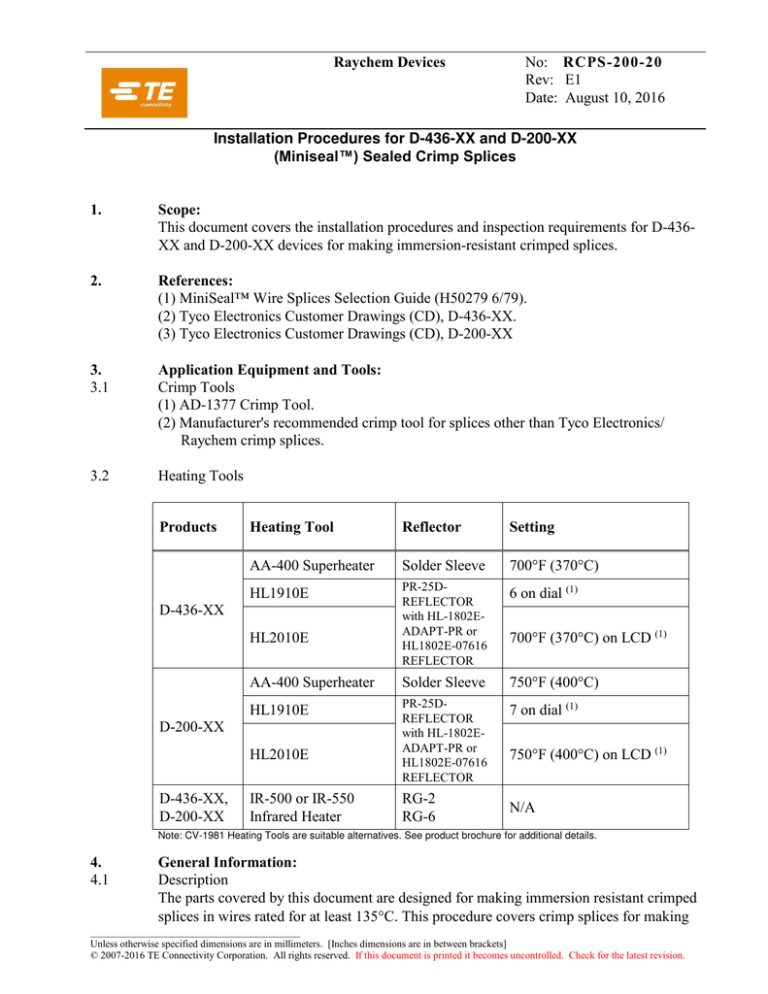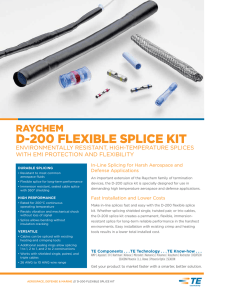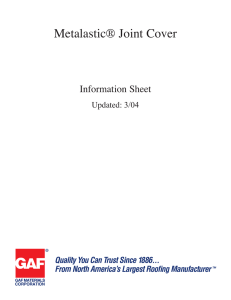
Raychem Devices
No: RCPS-200-20
Rev: E1
Date: August 10, 2016
Installation Procedures for D-436-XX and D-200-XX
(Miniseal™) Sealed Crimp Splices
1.
Scope:
This document covers the installation procedures and inspection requirements for D-436XX and D-200-XX devices for making immersion-resistant crimped splices.
2.
References:
(1) MiniSeal™ Wire Splices Selection Guide (H50279 6/79).
(2) Tyco Electronics Customer Drawings (CD), D-436-XX.
(3) Tyco Electronics Customer Drawings (CD), D-200-XX
3.
3.1
Application Equipment and Tools:
Crimp Tools
(1) AD-1377 Crimp Tool.
(2) Manufacturer's recommended crimp tool for splices other than Tyco Electronics/
Raychem crimp splices.
3.2
Heating Tools
Products
Heating Tool
Reflector
Setting
AA-400 Superheater
Solder Sleeve
700°F (370°C)
HL1910E
PR-25DREFLECTOR
with HL-1802EADAPT-PR or
HL1802E-07616
REFLECTOR
6 on dial (1)
AA-400 Superheater
Solder Sleeve
750°F (400°C)
HL1910E
PR-25DREFLECTOR
with HL-1802EADAPT-PR or
HL1802E-07616
REFLECTOR
7 on dial (1)
D-436-XX
HL2010E
D-200-XX
HL2010E
D-436-XX,
D-200-XX
IR-500 or IR-550
Infrared Heater
RG-2
RG-6
700°F (370°C) on LCD (1)
750°F (400°C) on LCD (1)
N/A
Note: CV-1981 Heating Tools are suitable alternatives. See product brochure for additional details.
4.
4.1
General Information:
Description
The parts covered by this document are designed for making immersion resistant crimped
splices in wires rated for at least 135C. This procedure covers crimp splices for making
_________________________________________
Unless otherwise specified dimensions are in millimeters. [Inches dimensions are in between brackets]
© 2007-2016 TE Connectivity Corporation. All rights reserved. If this document is printed it becomes uncontrolled. Check for the latest revision.
Raychem Devices
No: RCPS-200-20
Rev: E1
Date: August 10, 2016
Installation Procedures for D-436-XX and D-200-XX
(Miniseal™) Sealed Crimp Splices
both stub and in-line splices. Some of the parts in the D-436 and D-200 series consist of
sealing sleeves only. Parts are supplied in three basic configurations, according to the
number of wires that can be spliced together. These part and splice configurations are as
follows:
4.1.1
One-Wire to One-Wire In-Line Splices, or Two-Wire Stub Splices.
Parts for each splice are:
(1) One crimp splice.
(2) One sealing sleeve with two integral one-hole seals (shown).
4.1.2
Multiple-Wire to One-Wire In-Line Splices, or Multiple-Wire Stub Splices.
Parts for each splice are:
(1) One crimp splice.
(2) One sealing sleeve with one integral one-hole seal and one integral multiple-hole seal
(shown).
4.1.3
Multiple-Wire to Multiple-Wire In-Line Splices.
Parts for each splice are:
(1) One crimp splice.
(2) One sealing sleeve with one integral multiple-hole seal and one separate multiple-hole
seal (shown).
_________________________________________
Unless otherwise specified dimensions are in millimeters. [Inches dimensions are in between brackets]
© 2007-2016 TE Connectivity Corporation. All rights reserved. If this document is printed it becomes uncontrolled. Check for the latest revision.
Raychem Devices
No: RCPS-200-20
Rev: E1
Date: August 10, 2016
Installation Procedures for D-436-XX and D-200-XX
(Miniseal™) Sealed Crimp Splices
4.2
Applications
The sealing sleeves covered by this document are designed for immersion resistant splice
sealing when no more than one wire is inserted through each hole of the seals. In some
instances a maximum of two wires of specified sizes can be inserted through each hole of
the seals, with factory evaluation and approval.
5.
Procedure:
These procedures are for installing crimp splices and sealing sleeves of the D-436-XX
and D-200-XX series. Separate procedures are provided for parts conforming to
paragraphs 4.1.1, 4.1.2, and 4.1.3.
WARNING
Follow installation instructions carefully. Use adequate ventilation and
avoid charring or burning during installation. Charring or burning the
product will produce fumes that may cause eye, skin, nose and throat
irritation. Consult Material Safety Data Sheets RAY5106 for further
information.
5.1
Part Selection
Select the proper splice components for the application according to the applicable
drawing or to the Selection Guide, or Customer Drawings (CD). See section 2.
5.2
Wire Preparation
(1) Strip the wires to be spliced. If any conductor is to be folded back to increase the
effective cross-sectional area, strip that wire to twice the specified strip length.
Strip lengths:
The strip length for a particular crimp splice equals the length of the crimp barrel plus
0.8 - 1.6 mm (1/32 – 1/16 inch) See figure on next page.
For most AWG 12 and smaller crimp splices, the correct strip length is
7.9 - 8.7 mm (5/16 - 11/32 inch).
_________________________________________
Unless otherwise specified dimensions are in millimeters. [Inches dimensions are in between brackets]
© 2007-2016 TE Connectivity Corporation. All rights reserved. If this document is printed it becomes uncontrolled. Check for the latest revision.
Raychem Devices
No: RCPS-200-20
Rev: E1
Date: August 10, 2016
Installation Procedures for D-436-XX and D-200-XX
(Miniseal™) Sealed Crimp Splices
(2) If directed in the splicing tables to fold any conductors back, fold the appropriate
conductor(s) as shown below.
5.3
5.3.1
5.3.2.
One-to-one In-line Splices and Two-wire Stub Splices
Select proper slice components and prepare the wires as shown. (See 5.0.1, 5.0.2)
Splicing Procedure
(1) If making an in-line splice, slide the sealing sleeve onto either wire.
For stub splices, the sealing sleeve will be installed later.
(2) Crimp the wires in the crimp splice as shown in the appropriate figure below.
The gap between the end of the wire insulation and the crimp splice must be
0.8 - 1.6 mm (1/32 - 1/16 inch).
(3) Center the sealing sleeve over the splice area as shown.
_________________________________________
Unless otherwise specified dimensions are in millimeters. [Inches dimensions are in between brackets]
© 2007-2016 TE Connectivity Corporation. All rights reserved. If this document is printed it becomes uncontrolled. Check for the latest revision.
Raychem Devices
No: RCPS-200-20
Rev: E1
Date: August 10, 2016
Installation Procedures for D-436-XX and D-200-XX
(Miniseal™) Sealed Crimp Splices
(4) Heat (see Warning note) the sealing sleeve to shrink it and melt the seals as follows:
a. Use one of the heating tools listed in section 3.
b. Heat from one end toward the other. For stub splices, start at the end from
which the wires exit.
c. Continue heating until the seals melt and flow along the wire insulation and if a
stub splice, one seal melts and closes the end.
d. Allow the assembly to cool undisturbed.
WARNING
The heating tool and the assembly become hot during the installation of
the Sealing Sleeve. To prevent burns, allow tool and the assembly to cool
down before handling.
(5) Inspect the completed sealed splice per section 6.
5.4
5.4.1.
Multiple-to-one In-line Splices and Multiple-wire Stub Splices
Select proper slice components and prepare the wires as shown. (See 5.0.1, 5.0.2)
_________________________________________
Unless otherwise specified dimensions are in millimeters. [Inches dimensions are in between brackets]
© 2007-2016 TE Connectivity Corporation. All rights reserved. If this document is printed it becomes uncontrolled. Check for the latest revision.
Raychem Devices
No: RCPS-200-20
Rev: E1
Date: August 10, 2016
Installation Procedures for D-436-XX and D-200-XX
(Miniseal™) Sealed Crimp Splices
5.4.2.
Splicing Procedure
(1) Insert one of the multiple wires through each hole of the multiple-hole seal, and slide
the sealing sleeve back over the multiple wires as shown.
(2) Crimp the wires in the crimp splice as shown in the appropriate figure below.
* Make sure that the multiple wires do not become crossed between the multiple-hole
seal and the crimp splice.
(3) Center the sealing sleeve over the splice area as shown.
_________________________________________
Unless otherwise specified dimensions are in millimeters. [Inches dimensions are in between brackets]
© 2007-2016 TE Connectivity Corporation. All rights reserved. If this document is printed it becomes uncontrolled. Check for the latest revision.
Raychem Devices
No: RCPS-200-20
Rev: E1
Date: August 10, 2016
Installation Procedures for D-436-XX and D-200-XX
(Miniseal™) Sealed Crimp Splices
(4) Heat (see Warning note) the sealing sleeve to shrink it and melt the seals as follows:
a. Use one of the heating tools listed in section 3.
b. Heat the multiple-wire end first, until the multiple-wire seal melts and flows around
and along the wire insulation.
c. Move the heat toward the single-wire or open end, shrinking the sleeve along the
way.
d. Heat the second end until the seal melts and flows along the wire insulation or
closes the open end.
e. Allow the assembly to cool undisturbed.
WARNING
The heating tool and the assembly become hot during the installation of
the Sealing Sleeve. To prevent burns, allow tool and the assembly to cool
down before handling.
(5) Inspect the completed sealed splice per section 6.
5.5
5.5.1.
5.5.2.
Multiple-to-multiple In-line Splices
Select proper slice components and prepare the wires as shown. (See 5.0.1, 5.0.2)
Splicing Procedure
(1) Insert the multiple wires coming from one direction through the integral seal and
sleeve, one wire per hole, as shown.
_________________________________________
Unless otherwise specified dimensions are in millimeters. [Inches dimensions are in between brackets]
© 2007-2016 TE Connectivity Corporation. All rights reserved. If this document is printed it becomes uncontrolled. Check for the latest revision.
Raychem Devices
No: RCPS-200-20
Rev: E1
Date: August 10, 2016
Installation Procedures for D-436-XX and D-200-XX
(Miniseal™) Sealed Crimp Splices
(2) Insert the multiple wires coming from the other direction through the separate seal,
one wire per hole, as shown.
(3) Crimp the wires in the crimp splice as shown below.
Make sure that the multiple wires do not become crossed between either one of
the multiple-hole seals and the crimp splice.
(4) Push the separate multiple-hole seal up against the crimp splice.
(5) Position the sealing sleeve over the splice and over the separate multiple-hole seal so
that the separate seal is fully seated within the end of the sealing sleeve as shown.
Squeeze the wires together to hold the separate seal against the splice while
moving the sealing sleeve into position.
_________________________________________
Unless otherwise specified dimensions are in millimeters. [Inches dimensions are in between brackets]
© 2007-2016 TE Connectivity Corporation. All rights reserved. If this document is printed it becomes uncontrolled. Check for the latest revision.
Raychem Devices
No: RCPS-200-20
Rev: E1
Date: August 10, 2016
Installation Procedures for D-436-XX and D-200-XX
(Miniseal™) Sealed Crimp Splices
(6) Heat (see Warning note) the sealing sleeve to shrink it and melt the seals as follows:
a. Use one of the heating tools listed in section 3.
b. Heat the end with the separate seal first, until the seal melts and flows
around and along the wire insulation.
c. Move the heat toward the end with the integral seal, shrinking the sleeve
along the way.
d. Heat the end with the integral seal until the seal melts and flows around
and along the wire insulation.
e. Allow the assembly to cool undisturbed.
WARNING
The heating tool and the assembly become hot during the installation of
the Sealing Sleeve. To prevent burns, allow tool and the assembly to cool
down before handling.
(7) Inspect the completed sealed splice per section 6.
6.
6.1
Inspection:
Inspection for Proper Assembly
(1) The sealing sleeve must be centered over the splice area so that the melted seal
overlaps the wire insulation by at least 1-1/2 times the diameter of the wire insulation.
(2) The wire insulation must end at a point 0.8 - 1.6 mm (1/32 – 1/16 inch) from the
crimp splice.
6.2
Inspection for Proper Heating
(1) The sealing sleeve must be completely shrunk onto the splice area and wire insulation.
(2) The seals must be melted and flowed so as to lose their original shape as described
below:
a. If sealing a single wire, seal must be flowed along the wire insulation.
b. If sealing multiple wires, melted sealing material must be visible between
the wires where they exit from the sealing sleeve.
* Look between the wires to make sure that the center portion of the seal
has melted.
c. The free end of a stub splice must be completely sealed.
_________________________________________
Unless otherwise specified dimensions are in millimeters. [Inches dimensions are in between brackets]
© 2007-2016 TE Connectivity Corporation. All rights reserved. If this document is printed it becomes uncontrolled. Check for the latest revision.
Raychem Devices
No: RCPS-200-20
Rev: E1
Date: August 10, 2016
Installation Procedures for D-436-XX and D-200-XX
(Miniseal™) Sealed Crimp Splices
(3) The sealing sleeve must not be discolored to the point where it prevents visual
inspection of the splice (overheated condition).
6.3
Inspection for Damage
(1) The sealing sleeve must not be cut or split.
(2) The wire insulation must not show signs of mechanical damage or overheating, such
as cuts, tears, melting, charring.
7.
7.1
Inspection Photos:
Insufficient Heat (Unacceptable)
Meltable Inserts have not flowed
Then sealing sleeve not fully recovered
7.2
Proper Heating (Acceptable)
Meltable Inserts have flowed so as to lose their original shape
Then sealing sleeve is fully recovered
_________________________________________
Unless otherwise specified dimensions are in millimeters. [Inches dimensions are in between brackets]
© 2007-2016 TE Connectivity Corporation. All rights reserved. If this document is printed it becomes uncontrolled. Check for the latest revision.
Raychem Devices
No: RCPS-200-20
Rev: E1
Date: August 10, 2016
Installation Procedures for D-436-XX and D-200-XX
(Miniseal™) Sealed Crimp Splices
7.3
Over Heating (Unacceptable)
Wire insulation, sealing sleeve and meltable rings show signs of mechanical damage
or overheating, such as cuts, tears, melting, charring
1
These values are for reference only and may change based on other variables (i.e. reflector type,
sleeve's relative distance to the reflector, etc.)
DISCLAIMER
All of the above information, including illustrations, is believed to be reliable. Users, however, should independently evaluate the suitability of each
product for their application. Tyco Electronics makes no warranties as to the accuracy or completeness of the information, and disclaims any liability
regarding its use. Tyco Electronics' only obligations are those in the Standard Terms and Conditions of Sale for this product, and in no case will Tyco
Electronics be liable for any incidental, indirect, or consequential damages arising from the sale, resale, use or misuse of the product.
_________________________________________
Unless otherwise specified dimensions are in millimeters. [Inches dimensions are in between brackets]
© 2007-2016 TE Connectivity Corporation. All rights reserved. If this document is printed it becomes uncontrolled. Check for the latest revision.


